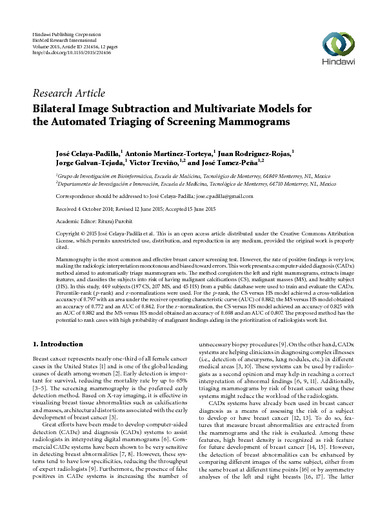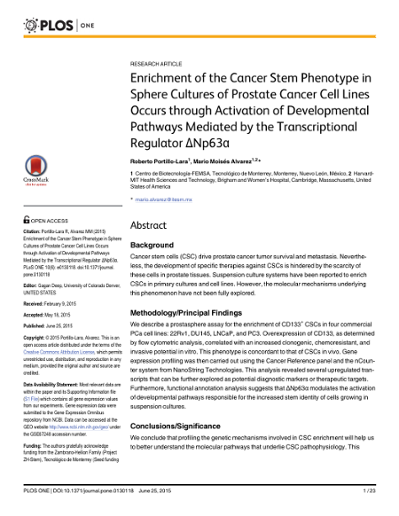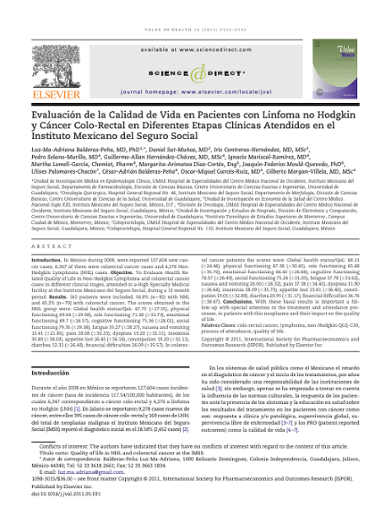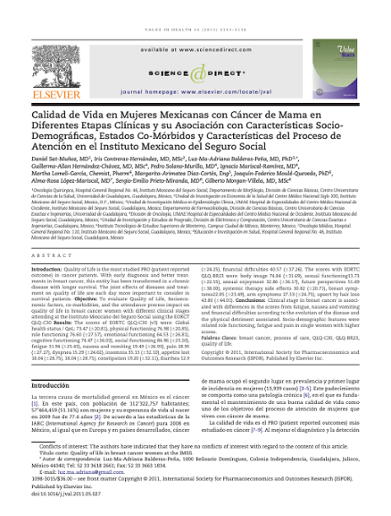| dc.creator | Celaya-Padilla J. | |
| dc.creator | Martinez-Torteya A. | |
| dc.creator | Rodriguez-Rojas J. | |
| dc.creator | Galvan-Tejada J. | |
| dc.creator | Treviño V. | |
| dc.creator | Tamez-Peña J. | |
| dc.date | 2015 | |
| dc.date.accessioned | 2018-04-09T17:15:20Z | |
| dc.date.available | 2018-04-09T17:15:20Z | |
| dc.identifier.issn | 23146133 | |
| dc.identifier.doi | 10.1155/2015/231656 | |
| dc.identifier.uri | http://hdl.handle.net/11285/628077 | |
| dc.description | Mammography is the most common and effective breast cancer screening test. However, the rate of positive findings is very low, making the radiologic interpretation monotonous and biased toward errors. This work presents a computer-aided diagnosis (CADx) method aimed to automatically triage mammogram sets. The method coregisters the left and right mammograms, extracts image features, and classifies the subjects into risk of having malignant calcifications (CS), malignant masses (MS), and healthy subject (HS). In this study, 449 subjects (197 CS, 207 MS, and 45 HS) from a public database were used to train and evaluate the CADx. Percentile-rank (p-rank) and z -normalizations were used. For the p -rank, the CS versus HS model achieved a cross-validation accuracy of 0.797 with an area under the receiver operating characteristic curve (AUC) of 0.882; the MS versus HS model obtained an accuracy of 0.772 and an AUC of 0.842. For the z -normalization, the CS versus HS model achieved an accuracy of 0.825 with an AUC of 0.882 and the MS versus HS model obtained an accuracy of 0.698 and an AUC of 0.807. The proposed method has the potential to rank cases with high probability of malignant findings aiding in the prioritization of radiologists work list. Copyright © 2015 José Celaya-Padilla et al. | |
| dc.language | eng | |
| dc.publisher | Hindawi Limited | |
| dc.relation | https://www.scopus.com/inward/record.uri?eid=2-s2.0-84937716018&doi=10.1155%2f2015%2f231656&partnerID=40&md5=6419c92a76ce386e5c043791f1d65a7e | |
| dc.rights | openAccess | |
| dc.source | BioMed Research International | |
| dc.source | Scopus | |
| dc.subject | Article | |
| dc.subject | automation | |
| dc.subject | breast cancer | |
| dc.subject | cancer risk | |
| dc.subject | cancer screening | |
| dc.subject | computer assisted diagnosis | |
| dc.subject | controlled study | |
| dc.subject | data base | |
| dc.subject | diagnostic accuracy | |
| dc.subject | diagnostic test accuracy study | |
| dc.subject | digital imaging | |
| dc.subject | human | |
| dc.subject | image enhancement | |
| dc.subject | image subtraction | |
| dc.subject | major clinical study | |
| dc.subject | mammography | |
| dc.subject | methodology | |
| dc.subject | probability | |
| dc.subject | radiologist | |
| dc.subject | sensitivity and specificity | |
| dc.subject | tumor calcinosis | |
| dc.subject | validation process | |
| dc.subject | workflow | |
| dc.subject | automated pattern recognition | |
| dc.subject | breast tumor | |
| dc.subject | computer simulation | |
| dc.subject | diagnostic imaging | |
| dc.subject | early cancer diagnosis | |
| dc.subject | echography | |
| dc.subject | emergency health service | |
| dc.subject | female | |
| dc.subject | mammography | |
| dc.subject | middle aged | |
| dc.subject | multivariate analysis | |
| dc.subject | procedures | |
| dc.subject | reproducibility | |
| dc.subject | statistical model | |
| dc.subject | Breast Neoplasms | |
| dc.subject | Computer Simulation | |
| dc.subject | Early Detection of Cancer | |
| dc.subject | Female | |
| dc.subject | Humans | |
| dc.subject | Image Interpretation, Computer-Assisted | |
| dc.subject | Mammography | |
| dc.subject | Middle Aged | |
| dc.subject | Models, Statistical | |
| dc.subject | Multivariate Analysis | |
| dc.subject | Pattern Recognition, Automated | |
| dc.subject | Reproducibility of Results | |
| dc.subject | Sensitivity and Specificity | |
| dc.subject | Subtraction Technique | |
| dc.subject | Triage | |
| dc.subject | Ultrasonography | |
| dc.title | Bilateral Image Subtraction and Multivariate Models for the Automated Triaging of Screening Mammograms | |
| dc.type | Artículo | |
| dc.identifier.volume | 2015 | |
| refterms.dateFOA | 2018-04-09T17:15:20Z | |



